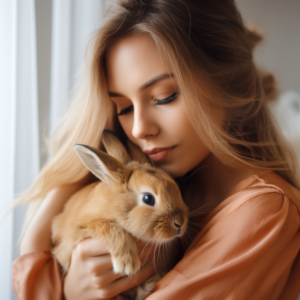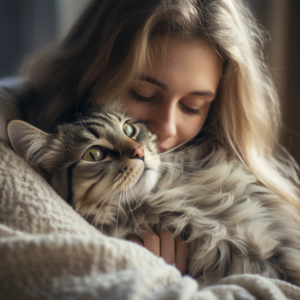In an ever-evolving world filled with stress and uncertainty, the quest for inner peace and emotional well-being is paramount. Traditional forms of therapy have long been in practice, offering solace and support to individuals grappling with various mental health issues. However, there’s a furry, feathered, or even scaly alternative that’s making waves in the realm of healing and mental well-being: pet therapy.
Chapter 1: A Fur-Covered Prescription
Pet therapy, also known as animal-assisted therapy or AAT, involves the use of animals to help people cope with and recover from various health issues, including mental health conditions. The concept is as simple as it is profound: animals, with their unconditional love and non-judgmental nature, have the remarkable ability to comfort, heal, and communicate in ways that often elude human interactions.
Pet therapy is a broad field that encompasses a variety of animal species, each contributing to the healing process in their unique way. From dogs and cats to horses, birds, and more exotic animals, the therapeutic benefits are as diverse as the animals themselves.
Chapter 2: The Science Behind the Fur
The healing power of pet therapy isn’t merely anecdotal; it’s deeply rooted in scientific principles. Interactions with animals trigger the release of oxytocin, a hormone associated with bonding and stress reduction. This chemical reaction in the brain has a direct impact on our emotional and mental well-being.
In this chapter, we explore the scientific evidence behind the effectiveness of pet therapy and how these interactions influence brain chemistry. We delve into studies showcasing the reduction in stress, anxiety, and depression levels in individuals who partake in pet therapy sessions.
Chapter 3: Furry Therapists: Dogs as Emotional Support
Dogs have long been recognized as “man’s best friend,” but their roles go beyond companionship. They serve as loyal allies in the fight against mental health challenges. We uncover the special qualities that make dogs exceptional emotional support animals, from their innate empathy to their ability to sense and respond to human emotions.
Chapter 4: Beyond Meow: The Healing Presence of Cats
While often seen as independent creatures, cats possess a soothing and calming influence that makes them ideal for pet therapy. We explore the unique characteristics that cats bring to the therapy setting, from their gentle purring to their ability to provide solace in moments of distress.
Chapter 5: Equine-Assisted Therapy: Horses as Healers
Horses, with their majestic presence and intuitive nature, offer a distinct form of therapy known as equine-assisted therapy. This chapter delves into the world of equine therapy, examining how the powerful bond between humans and horses can help individuals overcome trauma, anxiety, and depression.
Chapter 6: The Healing Melody of Birds
For those drawn to the enchanting world of avian companions, bird therapy offers a symphony of support. This chapter explores how the songs and chirps of pet birds, such as canaries and finches, can provide comfort and healing to those in need.
Chapter 7: Animal-Assisted Counseling: A Purr-fect Approach to Mental Health
The soothing presence of animals can extend to various mental health professionals. We investigate the role of pets in counseling sessions and how they create a welcoming and non-threatening environment for individuals seeking help.
Chapter 8: The Art of Alpaca Therapy
Alpacas, with their soft wool and gentle demeanor, have found their place in the realm of therapy. This chapter takes a closer look at alpaca therapy and how these woolly creatures offer comfort and peace to those they encounter.
Chapter 9: Aquatic Tranquility: Goldfish and Koi in Relaxation Therapy
In the serene world of underwater therapy, goldfish and koi take center stage. We explore the mesmerizing and calming effects of these aquatic creatures, especially in settings designed for relaxation and meditation.
Chapter 10: Reptilian Relaxation: The Comfort of Turtles and Tortoises
Reptiles might not be the first choice for therapy animals, but the slow and steady companionship of turtles and tortoises brings its unique form of relaxation. This chapter delves into the world of reptilian therapy and the comfort these creatures provide.
Chapter 11: Chirping Serenity: Canaries and Finches in Therapeutic Settings
The soft melodies of canaries and finches offer a sense of peace and tranquility. We explore how these delicate birds have found their place in therapy sessions, offering solace to those in need.
Chapter 12: Paw-sitive Progress: Dog-Assisted Therapy for Children
Children, in particular, benefit from the therapeutic presence of dogs. In this chapter, we discuss how specially trained therapy dogs assist children in overcoming emotional challenges, building self-esteem, and developing social skills.
Chapter 13: Healing Hooves: The Therapeutic Benefits of Goat Interaction
Goats might not be the first animal that comes to mind for therapy, but their friendly and playful nature makes them ideal for healing interactions. We explore goat therapy and how it promotes relaxation and joy.
Chapter 14: Pigeon Therapy: The Gentle Guidance of Homing Pigeons
Homing pigeons, with their remarkable ability to navigate vast distances, offer guidance and solace in therapy. This chapter delves into the role of pigeons in therapy sessions and their unique healing abilities.
Chapter 15: Butterfly Therapy: Finding Solace in the Company of Butterflies
The delicate and graceful presence of butterflies is not just a metaphor for transformation; it’s a reality in butterfly therapy. We explore how the presence of these ethereal creatures brings solace and encourages personal growth.
Chapter 16: The Call of the Wild: Wildlife Observation in Mental Health
Therapeutic wildlife observation takes individuals into the heart of nature. We discuss how observing and interacting with wildlife can promote mental well-being and a sense of peace.
Chapter 17: Hedgehog Hugs: The Soothing Touch of Prickly Companions
Hedgehogs, with their endearing appearance and gentle demeanor, offer a unique form of tactile therapy. In this chapter, we explore how these prickly creatures provide comfort and sensory stimulation.
Chapter 18: The Rabbit’s Ear: Listening Therapy with Pet Rabbits
Pet rabbits are not just for cuddles; they also provide listening therapy. We delve into the world of rabbit therapy and how the simple act of listening to these animals can promote relaxation and emotional healing.
**
Chapter 19: Animal Mindfulness: Embracing the Present with Animal Companions**
Mindfulness, the practice of being fully present in the moment, is complemented by the company of animals. We explore how the mindfulness that animals naturally embody can inspire individuals to find peace in the present.
Chapter 20: Insect Therapy: The Tranquil Influence of Fireflies and Ladybugs
Insects, like fireflies and ladybugs, bring a touch of magic to therapy. We discuss how these gentle creatures can inspire relaxation and wonder in those who seek their company.
Chapter 21: The Healing Hum of Bees: Apitherapy and Mental Wellness
The hum of bees carries a therapeutic essence. We explore apitherapy and how the presence of bees can promote relaxation and emotional healing.
Chapter 22: Tails of Transformation: Real Stories of Pet Therapy Success
In the final chapter, we share real stories of individuals who have experienced remarkable transformations through pet therapy. These heartwarming anecdotes showcase the profound impact of animals on mental well-being and the journey toward inner peace.
Conclusion: Embracing the Healing Power of Pet Therapy
The healing power of pet therapy is a testament to the profound connection between humans and animals. In the conclusion, we reflect on the diverse world of pet therapy and its potential to bring peace, solace, and transformation to those in need. Embracing the healing power of pet therapy is a journey toward greater mental well-being, one paw, wing, or fin at a time.



